 The
Masked Bookwyrm's Graphic Novel (& TPB) Reviews
The
Masked Bookwyrm's Graphic Novel (& TPB) Reviews
Aquaman ~ Page One
for a complete alphabetical list of ALL reviews start hereA - B - C - D - E - F - G - H - I - J - K - L - M - N - O - P - Q - R - S - T - U - V - W - X - Y - Z
"He was born Arthur Curry, half-breed son of man and mermaid, and rose to become ruler of the mighty sea kingdom of Atlantis...the dauntless defender of all the seven seas...
Aquaman: Deadly Waters, The Deluxe Edition (2020) 208 pages
Reprinting: Aquaman (1st series) #57-63, and the
Aquaman and/or Aqualad stories from Adventure Comics #49-56 (1970-1971)
Rating: * * * * (out of 5)
Number of readings: 1
Reviewed: Feb 2024
Additional notes: covers; a couple of behind-the-scenes editorials by Skeates that were published in the original issues.
This collection follows on the heels of The Search for Mera collection. That collection showcased an epic story (albeit one made up of adventures-of-the-month linked by plot threads and a story arc).
Deadly Waters settles down to smaller stories -- but in a lot of ways it is even more creatively ambitious. Or at least experimental. When Skeates & Aparo took over the title and immediately launched into The Search for Mera arc it was obvious their remit was to up-date and make the comic a little more sophisticated (by the standards of the day). Hence the epic story arc which was a far cry from the generally one-off plots the series had previously employed under writer Bob Haney and artist Nick Cardy. And in this collection it feels like Skeates (and Aparo) are continuing to push at the edges.
The stories range from to-be-expected undersea heroics to land-based crime-busting, there's a head trippy multi-issue sojourn in another dimension (with echoes of The Search for Mera idea) and a return of the very sixties criminal/spy organization, O.G.R.E. (seen in earlier issues of Aquaman). Stories range from full issues (or multi-issue) plots to issues broken up into lead and back up stories, including a three-issue run of Deadman back up tales that are linked with the lead Aquaman stories (and written and drawn by Neal Adams -- not only a comic book giant, but a seminal creator from Deadman's late-1960s adventures).
There's action, there's social commentary, there's satire, and there's some psychological exploration. As an example of the quirkiness there's a scene where we cut away to some odd little characters in the other dimension story and it's only if you think of it that you realize their alien names "Steev", "Jimm," and "Dikk" are, of course Steve (Skeates), Jim (Aparo), and editor Dick (Giordano).
I don't have a strong sense of Skeates' voice from the other comics I've read by him from that era, but this definitely feels like he was going through a maverick phase. A writer who had established himself as a reliable pro and now wanted to indulge his creative wild side.
Does it always work? No. The comics are still a product of their time and are working within certain constraints. The opening issue tackles the idea of industrial pollution but ultimately in a fairly anodyne way. The dialogue can be a bit corny.
But the imagination is quite intriguing, the wild way the comic veers from theme to theme, as if Skeates saw in the character (only a quasi-superhero after all) a blank canvas capable of sporting a variety of paintings. The O.G.R.E. story is, I think, supposed to be a bit cheesy -- but is nonetheless fun and excitingly told. And the final issue here is just wildly idiosyncratic with so many plot elements (and social commentary) it borders on being -- dare I say it? -- Steve Gerber-esque.
And read as a collection, it's fun how the issues can link with each other through sub-plots or foreshadowing, even as they are separate stories.
The unusual idea of interlinking the Aquaman-lead-story/Deadman-back-up-story further makes my point that it feels like everyone (including editor Dick Giordano) saw the title as a place to experiment. In ensuing decades I'm not sure too many people would cite Aquaman (even during popular runs) as necessarily a boundary-pushing series.
A major part of the success here is Jim Aparo's art. A respected and popular artist (I'm a fan), Aparo's art and style evolved over his two or three decade career, while also maintaining it's distinctive Aparo-esque look. He's mostly associated as a Batman artist (on a variety of titles and eras) as well as later revival of Aquaman (in Adventure Comics). Because his style evolved I'm not sure if his decision to draw Aquaman as surprisingly spindly (in his limbs) was just a look he was going for by that point (in The Search for Mera issues his Aquaman evolved from a burly version evoking the style of his predecessor-artist, Nick Cardy, to more lean and familiarly Aparo) but this seems even more extreme, as if maybe he saw Aquaman as an aquatic character who should be streamlined and almost fish-like.
And this early work by him is, at times, astonishing. In some ways peak work from him! The undersea environment is brought beautifully to life and the sequence in the other dimension is positively Ditko-esque in its psychedelic otherworldliness (as well as occasionally working subliminal words and images into the background shapes). It's a shame Aparo wasn't assigned more sci-fi type series in addition to the urban grit of Batman. It's gorgeous work. In an accompanying commentary by Skeates it's suggested Aparo's workload was deliberately lightened so he could put more time into those pages -- and it certainly paid off. But even in the other issues there's interesting visuals, use of angles, or unusual uses of shades or black & white sequences. No colourist is billed (possibly Aparo? I think he did the lettering, certainly) but the colourist definitely deserves credit for making both the naturalistic undersea scape and the bizarre other dimensional scenes so sumptuous.
Combine this with Adams' Deadman stories, as well as the striking and eye catching covers of the original issues by Nick Cardy (the previous Aquaman artist) and this is a collection where the art definitely justifies a lot of the purchase. I suppose that's partly because a series like Aquaman, with its undersea world and mix of sci-fi and fantasy, is a lot about sucking you into its milieu visually.
Perhaps the main weakness with the series (beyond the earlier acknowledged corny/cheesiness of the time), is Aquaman himself and his supporting cast. Skeates doesn't really do enough with him (or Mera, Aqualad, etc.) to make him stand out as a personality. Indeed, he's not even all that engaging (even as I don't think that was the intent -- I think the intent was just to make him a generic hero). Although arguably that has often been the struggle with Aquaman. The idea of the character is fine -- but what is his character?
Whether that was the problem, or maybe the series was just too unpredictable for readers of the day, it was cancelled. This collection doesn't end on a cliff hanger, and there are threads that are introduced and resolved (including how the arc set in the other dimension is then revisited a few issues later to tie up a problematic loose end). But Skeates was clearly laying the groundwork for future plots, too, including introducing a rabble rousing demagogue who was trying to turn the people against Aquaman and even a weird short tale introducing a sinister tunnel. But, alas, they never get to go anywhere.
But as a collection of Aquaman tales -- this turns out to be surprisingly intriguing, especially for its variety and experimentation. I read this around the time I read the more recent collection Aquaman: Deep Dives and yet funnily this run by Skeates & Aparo arguably evinces more variety and shows off more facets to Aquaman than that collection by a variety of creative teams!
I had started it thinking it wasn't as strong as The Search for Mera saga (which, similarly, grew on me and I liked more toward the end than the beginning) but as I close the book I'm not so sure. It's visually stunning at times and if maybe a bit hit and miss, equally that's what makes it enjoyable and a fun collection to revisit from time to time. Aquaman:
Death of a Prince (2011)
336 pages
Reprinting: Aquaman (1st series) #57-63, and the
Aquaman and/or Aqualad stories from Adventure Comics #435-437, 441-455
(1974-1978)
Rating: * * * (out of 5)
Number of readings: 1
Reviewed: July 2015
This collection of 1970s Aquaman stories seems to reflect
the growing trend in TPB collections of omnibus volumes. When comic book
TPBs initially began they tended to reprint specific story arcs or were
random "best of..." collections. But then Marvel and DC both discovered
success with their massive-but-cheap-black-and-white chronological reprints
(Essential/Showcase Presents respectively). This seemed to lead to colour
collections with more issues reprinted between a single cover.
So although this is called "Death of a Prince," as though
focused on a particular, seminal storyline, the truth is it really just
reprints, more or less, the entire run of Aquaman stories from this era.
Including some ancillary shorts focusing on Mera and Aqualad.
Aquaman's comic had been cancelled in 1971. So in 1974
he was revived for a three-issue back up in the pages of Adventure Comics.
Which then led to him taking over the main slot in Adventure. It must have
done well enough for Aquaman to resume his own comic again (starting the
numbering from where it left off in 1971) only to then have that get cancelled
in the so-called DC Implosion. So this collection reprints all of
that.
(Aquaman did enjoy a few more back-up series, but didn't
headline again until the late 1980s).
Now it's entirely possible this collection was intended
to simply reprint a story arc, but the editors were having trouble deciding
where it should begin and end (not an uncommon problem in comics -- heck,
I've read collections where you can think the editors missed including
crucial parts of the story). Despite different writers involved, plot threads
over lap, stories segue into each other, etc. In one of the first tales,
Aquaman thinks how he and Black Manta are destined for a showdown -- making
it seem like it's foreshadowing the later events in this TPB.
At this collections heart is the traumatic murder of Aquaman's
baby son, Aquababy (or Arthur Jr, if you want to be more dignified). An
event of sufficient impact on the character that it remains relevant even
though DC's universe has undergone more than a few re-boots since. Not
only that, these issues seemed a conscious attempt to re-shape the Aquaman
mythos. In addition to losing his son, he is dethroned from being king
of Atlantis, has a falling out with long-time sidekick, Aqualad, and even
his relationship with Mera begins its road toward dissolution.
Clearly the editorial decision was to jettison much of
the stuff around Aquaman and return him to being a lone wolf super hero
(though funnily enough, by the final issue here, it reunites the characters).
As a collection of Aquaman circa the 1970s -- this (literally)
can't be beat. But equally one could argue although there's nothing particularly
bad here -- there's little that stands out, either. Perfectly okay page
turners, but few individual issues/stories that are memorable in and of
themselves.
The art can't be faulted, much, with Jim Aparo handling
the lion's share -- Aparo who actually began his career at DC on Aquaman
a few years before. His art here is, arguably, smoother, more confident
than in those previous Aqua-stories -- more distinctly his style. But equally
it's lost some of its earlier detail, its atmosphere. Arguably the very
act of becoming more confident means it's a little less creative. But it's
still good work from a top tier artist. Don Newton takes over toward the
end, also a fine artist (and who would continue his association with Aquaman
in some later back-up stories) -- though Newton's soft, organic style can
be compromised depending on the inker he's paired with. The initial three
short tales are drawn by Mike Grell, though definitely early in his career,
and not as effective as he would become. Rounding out the solid art are
back up tales with Juan Ortiz drawing a Mera trilogy, and Carl Potts some
Aqualad tales.
The problem here lies mostly with the scripts -- with
a variety of writers involved, but a sense no one has quite tapped into
an inner muse. The plots are mostly just thin stories to support the action,
with a lot of one-note villains engaged in fairly simple schemes. And with
on going threads that never quite develop into much. Contrast this with
the imaginative plotting of the much earlier stories reprinted in Showcase
presents Aquaman, vol. 3, for instance -- though, to be fair, many
of the issues here are only 12 pages or so.
I had recently been reading an earlier run of Aquaman
(collected as the Search for Mera TPB ~ reviewed further down) -- and found myself commenting on that run's conspicuous
lack of recurring super villains. But this run -- well, it's almost entirely
a parade of costumed foes (some recurring more than once, such as The Fisherman,
Black Manta, Ocean Master, and with others such as The Scavenger dropping
by, and Kobra -- DC's attempt to create a cross-title uber-villain -- pulling
the strings at one point). And the problem with relying too much on familiar
foes is it becomes a crutch to avoid having to come up with complex plots
or motivation. There's also a story arc wherein someone usurps Aquaman's
throne -- recycling a plot thread from the Quest for Mera arc.
I also found the handling of Aquaman's abilities a bit
repetitious. Obviously the fact that he can telepathically summon sea creatures
is a nifty power -- but it probably is cooler used sparingly. Here, every
issue he relies upon it multiple times, and not really with much innovation,
or unusual applications.
And maybe part of the problem with so many of the issues
and story arcs seeming mainly intended to change the status quo is that
can smack a bit of creators who aren't sure what to do with the property
(like the cliche of a writer who sits at his desk, shuffling papers, changing
typewriter ribbon, etc. -- rather than just getting down to the writing).
Even Aquaman himself has trouble coming into focus. There's an attempt
to play up Aquaman as slightly brusque and bitter (even before his son's
death), but not enough to really make that his personality (ala The Sub-Mariner's
hot-headedness) but enough to make him not wholly likeable.
Even the idea of "revealing" that Black Manta is a black
man can feel like part of this desire to toss in a change for the sake
of change (and that's sidestepping whether that decision -- presumably
inspired by the plethora of black characters with "Black" in their name
-- just seemed a bit corny).
A lot of these changes feel perfunctory.
Nowhere is this more problematic than in the death of
Aquababy. It's such a major change to the series -- yet just feels like
creative house cleaning! There's very little build up or foreshadowing
of it (no ominous warning on the issue's cover of the shocking event inside).
And though it supposedly makes Aquaman embittered for the next few issues
-- often it's barely noticeable, his dialogue often just as blithely cocky
as usual, hardly like a man who just lost his only son! I suspect that's
because the creative team (by this point with Michelinie as the writer)
weren't really approaching it from an emotional perspective. It was merely
as an opportunity to get rid of an unwanted story element.
Even all these years later I have some ethical qualms
with a comic killing a toddler so cavalierly. I'd also argue that the fact
that Aquaman was a family man, far from being a creative albatros around
the character's neck, was actually a unique story aspect given he was practically
the only super hero whose cast included a family.
With that said, the issue immediately following Aquababy's
death -- Aquaman #57, with Aquaman having his showdown with Black
Manta -- stands out. It feels a bit more atmospheric, set amid a sunken
graveyard of ships, and is bolstered by the actions of a supporting character.
It's one of the few times in these issues that there's any attempt to enrich
the drama by giving some complex emotion to a secondary figure.
Ultimately I do have a long-time affection for Aquaman
and the undersea milieu (I also like the Sub-Mariner). And as a grab bag
of Aquaman tales, you can't really fault this. But despite featuring seminal
changes to the character's life, few of the stories stand out here. Whether
individual issues or multi-issue sub-plots. Perhaps it reminds you that
just because certain issues might be "important" in terms of the development
of the character -- it doesn't mean the storytelling itself was anything
exceptional.
Aquaman:
Deep Dives (2021)
168 pages
Reprinting: Aquaman Giant #1-4, which reprinted stories from the on-line Aquaman: Deep Dives #1-9 (2020) - with covers Rating: * * * 1/2 (out of 5)
Number of readings: 1
Reviewed: Feb 2024
Deep Dives is a collection of Aquaman stories from different writers and artists. They were originally presented on-line, then printed in comic book form in a series of Aquaman Giant comics before being assembled in this collection. But instead of just being "short" stories -- which can limit the tales -- there's a nice range: from as short as eight pages to as long as twenty-four; and though most are independent of each other, some link up to create a longer, epic story.
The on-line-first anthology format has resulted in a series of Batman collections (under the new Legends of the Dark Knight title) and Wonder Woman (in the Agent of Peace collections and other titles) often to very good effect.
Deep Dives isn't as strong as the Batman and Wonder Woman versions (at least, of the ones I've read). But -- weirdly enough -- even as I'm drafting this review my opinion is altering a bit. My review (that follows) leans a bit on the negative, but at the same time the collection does manage to hit the goal it sets for itself: to simply be a grab bag of Aquaman (and related characters) adventures, mostly self-contained and not requiring knowing every bit of minutia in concurrent storylines. A book to have on the shelf and dip into whenever you have a hankering for the King of the Seas.
But onto the deeper review:
The art varies from quite good to just okay (with bigger names, like Aaron Lopresti, and less familiar names contributing) and the writing tends to range from solid to a bit ho-hum. Despite the anthology intent, some writers and artists contribute more than others. Writer Steve Orlando (who has written the main Aquaman comic) contributes no less than five stories, including the collection's three-part epic (with artist V. Ken Marion).
But too many of the stories are just built around big action sequences and/or long fights. You can't accuse them of being boring, but there's little in the way of interesting plots unfolding in interesting ways or showcasing different facets of the character or his world. While a few others lean towards being "serious" or character pieces. But despite the average length being about sixteen pages, both extremes can feel like they were intended for "short" filler stories.
I was going to suggest maybe Aquaman just doesn't lend himself to variety (the way, say, even Batman stories can vary from superhero to detective to horror); but that's not really true. Just thinking of the Steve Skeates Aquaman era collections (The Search for Mera and Deadly Waters) the stories ranged about a lot.
In the centre of this collection is a three-part tale -- actually, it's almost a four parter in that there's a story here where Aquaman encounters the Sea Devils (a team of naval adventurers that started out -- way back in the 1950s -- as a kind of aquatic version of The Challengers of the Unknown but over the years became more quasi-eco-terrorists) and hires them to act as intermediaries between Atlantis and the surface world. It can almost serve as a prologue to the three parter as the Sea Devils guest star in that arc as well.
But even the three-parter feels a bit underdeveloped as a plot, more just built around big fight/action scenes. Perhaps deliberately it echoes a few Aquaman sagas of the past, as a sub-plot involves someone trying to turn the Atlantean population against Aquaman. But in a way that feels like we're skimming over a plot that needs more detail (almost like a Reader's Digest version of this kind of Aquaman story line).
It also is problematic (in a way that echoes such past stories) in that the moral/politics of the story are a bit muddled. You could see it as a comment on modern right wing populism, because the public is being turned against Aquaman by a rabble rousing media campaign that lies about and misrepresents his actions -- yet it's hard to entirely root for the undemocratic king whose rule is defined by how well he can protect the people (in other words: might).
Part of the problem with this collection may lie with Aquaman himself. As a kid I had a fondness for Aquaman, perhaps as much for the idea and the milieu (since I also liked Marvel's Sub-Mariner). But even though I've liked Aquaman stories and collections as an adult, I'll admit I don't always have a strong sense of "who" he is, character-wise. And I'm not sure the writers do, either. The weird thing (looking at the collections I've reviewed on my site) is how Aquaman often seems to get radically altered and re-imagined while at the same time his cast and milieu seems to change hardly at all.
These stories feature a fairly standard Aquaman: king of Atlantis; Mera at his side; orange and green costume. Though instead of clean shaven he's depicted with longish hair and a beard (perhaps to make him look a bit more like Jason Momoa from the movies?) But as a character he's a bit vague and generic (sometimes brusque, others less so). Likewise the supporting characters can be equally vague or inconsistent (Tula a.k.a. Aquagirl is depicted quite differently in the two stories she appears). Even stories meant to be character-heavy -- such as a couple of short pieces focusing on the modern Aqualad (who's the son of bad guy, Black Mantis) -- leave you with the impression of a nice, but forgettable, hero. The original Aqualad, now called Tempest, crops up in a story -- but the character focus means little if you don't know the greater context (which I didn't).
With all that said, the counter point is there's little that's bad here, either. There may be few high points, but few genuine low points, either. After my initial cynicism/criticism has started to cool, even I can see going back and re-reading some of the stories. And as a collection of Aquaman stories to have on the shelf it certainly serves as a decent sampler.
The stories range from short tales, to more-or-less feature length (ie: single issue) adventures, to a multi-part "epic" complete with a sub-plot. You get Aquaman (of course), Mera, Aquagirl, both Aqualads, and the Sea Devils, and appearances by some recurring adversaries, plus original threats. It's (mostly) self-contained so you aren't left scratching your head wondering about what it was about because it links to some other storyline. Although you might wonder how or if some of them relate to current continuity (the stories may jump about in time, and seem to be before Aquaman and Mera have a baby -- let alone the baby being killed -- but I don't know if that makes them "retro" tales or whether that's just the current re-booted continuity).
In a sense it serves the same function as a kind of "Best of..." collection in that it's a bunch of stories by different creators that you can dive (no pun intended) back into from time to time.
And in that sense, I suppose it does the trick. 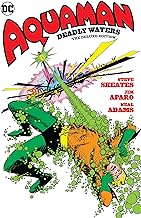 Written by Steve Skeates, with Neal Adams. Illustrated by Jim Aparo, with Neal Adams.
Written by Steve Skeates, with Neal Adams. Illustrated by Jim Aparo, with Neal Adams.
Colours/letters: unbilled (though possibly Aparo and Adams).
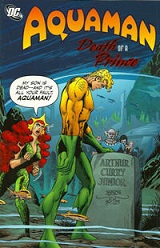 Written
by Paul Levitz, David Michelinie, Steve Skeates, Paul Kupperburg. Illustrated
by Jim Aparo, Don Newton, with Mike Grell, Juan Ortiz, Carl Potts. Inked
by various.
Written
by Paul Levitz, David Michelinie, Steve Skeates, Paul Kupperburg. Illustrated
by Jim Aparo, Don Newton, with Mike Grell, Juan Ortiz, Carl Potts. Inked
by various.
Colours/letters: various.
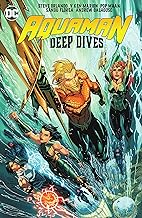 Written by Steve Orlando, various. Illustrated by V. Ken Marion, Aaron Lopresti, Jose Luis, others.
Written by Steve Orlando, various. Illustrated by V. Ken Marion, Aaron Lopresti, Jose Luis, others.
Colours/letters: various
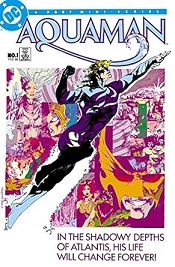 (1986, four issues, DC Comics)
(1986, four issues, DC Comics)
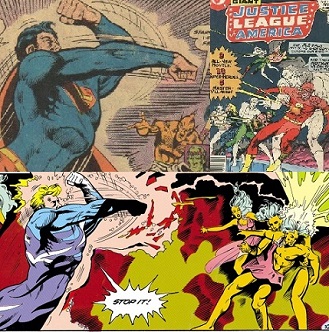 There were also a number of panels I could identify as "swipes" (where the artist is clearly basing his drawing on a previous artist's work) and others that looked naggingly familiar. But I can't say how often he does it. Now I'm not going to get into the ethics of swiping -- whether it's legitimate in certain contexts (all artists often use reference material). But it can create compositional problems since the characters can seem to be affecting odd poses for the scene, or expressing an odd facial reaction (since the artist is "borrowing" a pose from a different scene in an unrelated story). There were scenes where Hamilton drew characters just kind of standing about as if he wasn't quite sure what to do with them. (The example images contrast an Aquaman panel with an interior image from Superboy and the Legion of Super-Heroes and a cover from The Justice League of America)
There were also a number of panels I could identify as "swipes" (where the artist is clearly basing his drawing on a previous artist's work) and others that looked naggingly familiar. But I can't say how often he does it. Now I'm not going to get into the ethics of swiping -- whether it's legitimate in certain contexts (all artists often use reference material). But it can create compositional problems since the characters can seem to be affecting odd poses for the scene, or expressing an odd facial reaction (since the artist is "borrowing" a pose from a different scene in an unrelated story). There were scenes where Hamilton drew characters just kind of standing about as if he wasn't quite sure what to do with them. (The example images contrast an Aquaman panel with an interior image from Superboy and the Legion of Super-Heroes and a cover from The Justice League of America)
